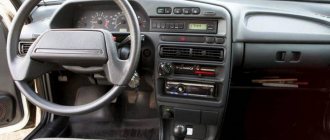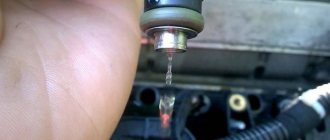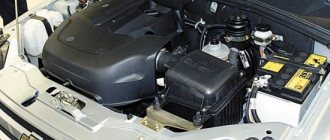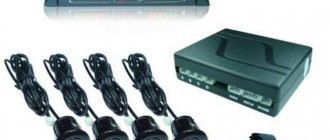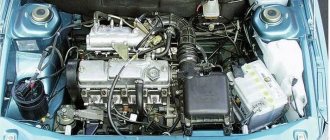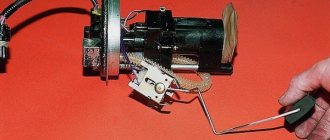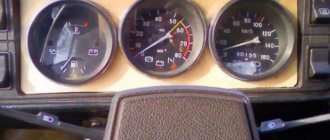Published:
15.03.2016
Parktronic or parking radar is a small device that not only makes parking a car easier. It also ensures road safety by signaling if an obstacle or another vehicle is too close. And if the car’s parking sensors are broken or simply don’t work, then for inexperienced drivers, as well as those who are accustomed to its constant prompts, this can become a real problem.
What are parking sensors?
Before moving on to the causes of breakdowns, let’s briefly consider what the device is.
Parktronics or parking radar is a system of contactless sensors, ultrasonic or electromagnetic, that scans the space within the radius of its sensitivity zone for the presence of foreign objects. When the latter are detected, a sound indicator starts to work, and, if the kit includes a graphic display, the distance to the obstacle is displayed on a colored segmented scale. Thus, parking sensors allow the driver to safely maneuver the car in confined spaces, including when reversing.
The device is simple in configuration. There are several types of sensors: they are ultrasonic or electromagnetic. The second ones are attached to a magnetic tape that acts as an antenna, the first ones are mounted, each separately. By the way, electromagnetic sensors can be placed on the inside of the body, but ultrasonic sensors must be located on the outside, so they require drilling holes in the bumper.
The sensors are placed on the front or rear bumper of the car (or in combination), and the wires from them are pulled into the cabin to the control unit. An indicator is also installed there - a buzzer (sound emitter), an LED display (with a graphic scale) or an LCD monitor. The electronic unit is connected by a cable to the reversing lights (for connecting rear parking sensors) and brake light or turn signal lamps (for front sensors).
That's all. The parking radar operates automatically as soon as the gearbox lever is switched to reverse mode or the vehicle speed drops below 20 km/h.
Next, let's look at the main reasons why such a simple mechanism as parking sensors stopped working.
Design features and types
Regardless of whether you use standard or self-installed parking sensors, it may fail. Moreover, we will consider a situation where everything was fine, but suddenly the radar stopped working.
Electromagnetic and ultrasonic types of parking sensors are used on sale and as standard equipment for cars. They have slightly different principles of operation, since they are based on the use of different sensors. If we talk about Russia and the CIS countries, then ultrasonic systems are more in demand here. They are divided into wireless and wired. This issue should be dealt with separately if you plan to install a radar yourself or through a car service that was not provided from the factory.
The design of ultrasonic systems uses ultrasonic sensors and a control unit. In fact, the block is the brain of the equipment.
As for the electromagnetic analogue, that is, the role of the sensor is taken on by a metallized tape. It is fixed to the inside of the bumper. Using the tape, an electromagnetic field is generated. When an object or obstacle hits it, the sensor transmits a signal to the control unit, which informs the driver of the danger.
The advantage is on the side of the electromagnetic option. This is due to the fact that here, unlike its ultrasonic competitor, there is no such thing as blind or dead zones. Such tape-based systems provide better control over strictly defined distances and areas. That is, they are characterized by a more efficient and accurate reaction to what is happening in front and behind the car. But there is no limit to perfection. Increasingly, the car receives not only a standard radar, but also an additional camera. This allows you to combine graphics, sound signals and video images.
Objectively, the benefits of rear parking sensors are much greater than those of the front ones. But the latter also greatly helps the driver to maneuver in certain situations.
Common Causes
Parking sensor malfunctions occur due to a malfunction of the main components of the device.
Sensors don't work
- The ultrasonic sensor may be dirty. It is attached from the outside, so dirt, dust, ice, and snow could easily stick to it. The sensitivity of the gadget may have decreased. Also, ice on the sensor is a common cause of false alarms or situations when the parking sensors do not turn off. The system recognizes ice as a potential collision object, located dangerously close, and therefore screams heart-rendingly, honestly performing its task.
- Water or moisture could get into the places where the sensors are inserted due to a violation of tightness and insulation. The cause may be wear, careless operation, or even too intensive body washing. Water could cause a short circuit in the wiring or complete failure of the device.
- Remember if you hit the body of the car in the places where the parking sensors are located. They may not work due to mechanical damage, distortion, or falling inside the insertion point.
- A problem with parking sensors may arise due to unstable mounting, when the sensors dangle in the housing.
- Also, do not exclude the possibility of a manufacturing defect. It's good if the problem showed up right away. It’s worse if the parking radar was working, but suddenly stopped. In this case, it will be extremely difficult to establish a manufacturing defect as the cause.
Also, a “dead” sensor may be indicated by a message on the indicator screen “Parking sensor error E1”. For error codes, look in the owner's manual for your car, in the parking assistant section (it's called differently for different brands, but it's similar). For example, on a Volvo the message “Park Assist Service Requ 106” appears.
The reason is in the control unit
Why aren't the parking sensors working yet? The control unit may be broken.
- If the device has a self-diagnosis option, it will automatically detect this problem and display a corresponding notification on the display. If there is no such function, check the parking sensors yourself at home. It is not difficult.
- Dust or moisture may have gotten inside the device. During the wet season, the control unit could become damp from the inside, as a result of which the elements of the microcircuit board were oxidized;
- Faulty parking sensors, sometimes they are not. It may work, but you have set the sensitivity threshold too high in the settings. So the indicator beeps with every breath of wind or incorrectly determines distances;
- The parking sensors failed due to a failure in the electronic “brains” of the device;
- If your parking sensor display does not work or the buzzer does not beep, check the wiring. Perhaps the reason is that the contacts have come loose somewhere. Also, one should not exclude the possibility of failure of this element due to natural wear, penetration of dirt, moisture, or mechanical stress.
- If the monitor does not show the distance, but there is sound and the parking sensors are blinking, look for the reason in the operation of the display.
- If you find that the parking sensors do not work after replacing or completely discharging the battery, it is likely that a system error has entered the parking system computer due to lack of power.
Wiring not working
If your parking sensors suddenly stop beeping, you should start looking for what the reason is with the wiring. A break or interruption could have occurred in some place. Other reasons include loose or oxidized contacts, torn insulation, and a broken main power cable.
If the parking sensors do not work and do not turn on when you engage, specifically, reverse gear, the wire that powers the system from the reverse lights is probably broken. A similar reason could happen to the cables leading to the turn signals or brake lights (if the front sensor does not work).
Repair and replacement of parking sensors from A to Z
If recently parking sensors were considered a luxury, then in a big city where finding a parking space is quite difficult, it has become a necessity. If the parking sensors do not work, then for those who are used to using them, this is a real problem. The article discusses the main malfunctions of the device, ways to check the sensor, and provides instructions on how to disable, remove and replace the device on your car.
Diagnostics
You can check the functionality of the sensors tactilely. Firstly, when activated, if you lightly touch them, you should feel a slight vibration. Secondly, rhythmic clicking sounds can often be heard. As a last resort, the sensors are dismantled and each one is checked with a multimeter.
The self-diagnosis option will help you find out whether the electronic unit is working normally. Forcefully launch it through the settings and wait for the result.
If your device does not have this function, you will have to observe and test the parking sensors, as they say, “in battle.” Place any non-dangerous obstacle and check whether the radar will work and detect its presence in its sensitivity zone.
Frosty weather
One of the common situations is that the parking sensors constantly beep in the frosty and snowy seasons. This occurs due to the accumulation of ice and snow on the car bumpers. The simplest thing is to clean the sensors from ice and foreign contaminants.
If it is not possible to restore functionality using a simple method, the reason may be the freezing of the liquid that forms on the surface of the parking sensors. Place the machine in a dry, heated area to thoroughly dry the electronics.
Solutions
So, we have listed the main reasons why parking sensors often fail. Now let's outline all possible solutions:
- In order for the sensors to work, they need to be cleaned, both externally and internally. To do this, you will have to perform dismantling, first removing the bumper. The sensors are wiped with a soft cloth, dried, and traces of oxide and growths are removed with sandpaper. To free the locators from ice, drive the car into a warm box and dry the elements thoroughly (disassembly is not necessary).
- To restore the insulation at the insertion points when you insert the sensors back, use sealant.
- If you suspect misalignment or instability of the fastening, you should adjust the fit of the sensors.
- If you realize that the sensor does not work based on the code displayed on the screen, you will have to contact a service center.
- The control unit, as well as the monitor, buzzer or LED display, can be disassembled, cleaned of dust with a soft brush, and sanded down areas of visible oxidation with sandpaper. It would be a good idea to dry the device in a warm room;
- Take a good look at the gadget’s settings, lower the sensitivity threshold manually, and calibrate the accuracy;
- If the parking sensors stop working after replacing the battery, try resetting the gadget to factory settings. Another simple solution is to disconnect/connect the battery. This method works surprisingly often - system errors disappear without a trace.
- If the electronic unit still does not work after all the manipulations, alas, contacting qualified technicians cannot be avoided. They will repair or replace the sensors.
- If you come to the conclusion that the parking radar is not working due to the wiring, you will have to check all the cables. Using a multimeter, test each wire from the sensor to the control unit, as well as the cable from the unit to the headlights. If necessary, the wiring is completely restored.
Instructions for dismantling and replacing the device
The need to replace the sensor arises if a stone gets into it. Even a small pebble can break the mirror of the device. In this case, it cannot be restored. There is only one way out - replacement with a working device.
Replacing a sensor at a car service center in most cases is very expensive, so it’s easier to buy a new device and repair the parking sensors yourself.
When choosing a sensor, it is important to select one that exactly fits in size and characteristics.
The replacement procedure is simple. Before removing the sensor, you need to disconnect the wires from it. After turning off the power, you can remove the old device. Then you need to take a new sensor, connect the wires and secure it to the inside of the bumper.
It is possible that the old and new device will differ in color. Their design allows for the application of small amounts of paint. Therefore, they can be painted in any suitable color. Before painting, the surface should be degreased so that the paint lasts longer.
Price issue
How to avoid problems with sensors
As practice shows, most often parking sensors stop working due to a malfunction on the sensor side. No wonder, because they are located outside the body and are constantly exposed to environmental factors.
If you want to extend the life of your parking radar, keep all its elements clean, wipe off dust and dirt, and dry them if they get wet. Ask car washers not to direct a powerful stream of water into the area where the parking sensors are located. Check the tightness of the connections between the sensors and the bumpers.
Periodically check the integrity and general condition of the wiring. Wipe off dust from the control unit frequently. These seemingly simple actions help to significantly extend the life of any parking radar. Handle equipment with care!
Repair wisdom
Performing diagnostics dictates the choice of an effective method for correcting defects. If the parking sensors constantly beep, we are talking about contamination of the sensors. It is necessary to inspect them, wipe the sensors with a dry soft cloth. He especially likes to make such sounds on a frosty day or after washing. This happens because water gets into the sensor and freezes in the cold. Drying the device eliminates the need for repairs. To do this, you can put your favorite “swallow” in a heated room.
Setting matters in this matter: if the sensors are configured incorrectly, you have to deal with the annoyingly stable signal of the device. Whether the beeping occurs or not, the likelihood of replacing the sensors is close. It is better to do this in the service. To avoid reaction to growing grass, you will need to adjust the sensitivity of the devices. A service book and a pair of screwdrivers are eternal companions for self-repair, but it’s better not to do this: the process is labor-intensive and not justified. Service station specialists with professional knowledge, a competent approach, and knowledge of the technical condition will figure out what’s wrong much faster and find the most effective tactics for troubleshooting.
Functional highlights
The system is supplied by the manufacturer with a camera, transmitting and receiving units. The video image enters the transmitter unit, which sends data to the receiver. The picture is displayed on the monitor, helping the driver to park close to other cars, eliminating “blind spots”, without touching other people’s vehicles. Sealed rear view cameras and infrared illumination have a beneficial effect on parking at night. The best option is a harmonious union of the camera with the electronic system. This is the ability to recognize obstacles when sensors cannot cope with this task.
Special radars
Experience shows that the presence of a large number of sensors will ensure high-precision products. Branded models are in trend, so it is recommended to pay attention to the name of the manufacturer and get acquainted with the experiences of other traffic participants on forums. There are special models on the market - parking radars with 8 sensors, expanding visibility by 100%. Some foreign cars already have such a mechanism, so you don’t need to buy it separately. These include options Park Master8FJ-27, Phantom DP 8Z, etc. They provide an LCD display, sound indication in Russian, interesting lighting, and a shape that gives a special charm to the car. The models allow you to quickly park vehicles without any incidents. Overhead models are available for sale and can be installed without assistance.
Installation details
For installation, all contents must be removed from the luggage compartment. Power can be supplied from the reversing light: when reverse gear is engaged, the radar structure is simultaneously turned on. To install the block, you can use the niche for storing the jack. The power supply is carried out by a single-core extension cord, which is connected to the “+” of the headlight, insulating the connection. The wire is led to the installation site of the parking sensors unit. Next, you need to remove a small part of the insulation on the positive wire and attach the extension wire to the supply headlight. High-quality insulation will be required. When removing the trunk sealing rubber, the extension wire is passed under the casing material with output into the unit installation niche. The extension wire itself is ultimately connected to the “+” of the block. Next you will need four sensors.
The minimum height from the ground to the installation site must be at least 45 cm. For placement on the bumper, some versions of parking devices come with a marking ruler; with its help, it is easier to fix the sensors by resorting to drilling. Not everyone can do this job; it is better to turn to specialists, because even with the right actions, mistakes can occur. Parking sensors are not that easy to install.
